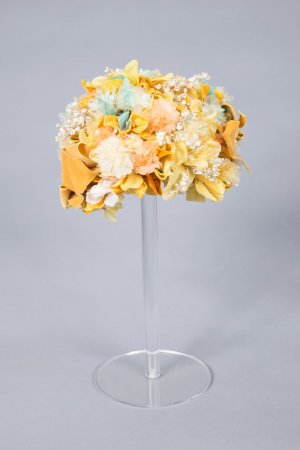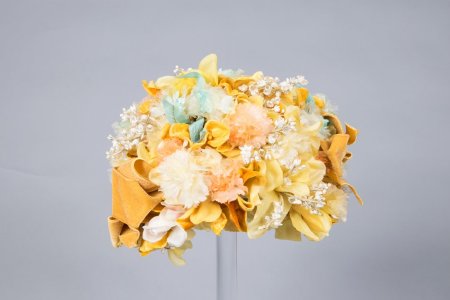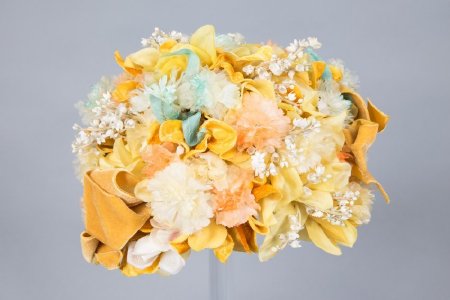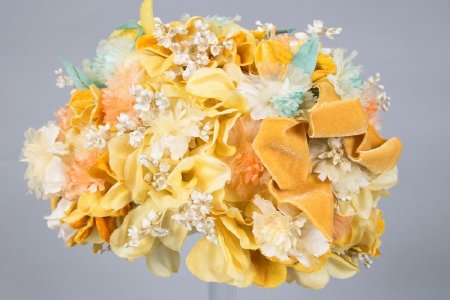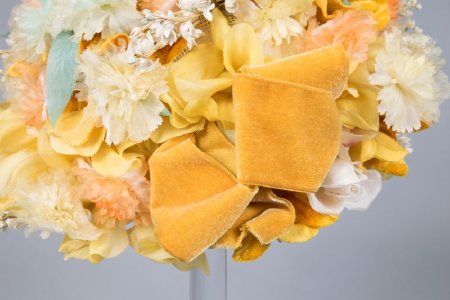Object ID:
2010.3.1
Label/Maker:
Jeanne Eileen
Date:
1960s
Object Details:
This lively pastel pillbox wedding hat dates to the 1960s and was designed by Jeanne Eileen. Often going under the name of Miss Eileen, Jeanne Eileen designed hats and accessories in the 50s and 60s. Covered entirely with synthetic "silk" flowers, orange, yellow, mint, pink, and white shades burst forward from the hat. Adding to the flowers, there are two orange velvet ribbons that feminize this piece through its materials. During this period, as headwear was loosing its influence, milliners used creative variety to entice female consumers.
Reference:
Cultural Connections:
The use of floral motifs in fashion has spanned throughout history as a measure of societial expression. During the late 18th century and into the early decades of the 19th century, the Neoclassical movement replaced the Baroque and Rococo eras. With an aesthetic grounded in antiquity and the classical beauty of ancient Greece and Rome, dress took on a sleek silhouette that promoted the importance of natural embellishments.8 Floral motifs in this period took the form of garlands and wreaths, as well as bouquets set in Greco-Roman vases.9 In the 1816 Ackermann illustration, the flowers that circle the lady's skirt as well as those that are positioned around the head, evoke the influence that trading clipper ships had on bringing exotic flowers into Britian, Europe, and the United States as an aesethtic trend which influenced both clothing and accessories.
The 1960s brought forth the hippy movement, and in congruence, flower power which was used as a resistence to war and violence. The flower motif was often evident in large, bubbly, bright, and psychedelic styles. Flower patterns were not only confined to bold representations but featured in a more conservative, although still playful manner, as demonstrated in the synthetic flower-covered wedding hat. In both the Ackermann illustration and the 1960s hat, the flower motif creates a design focus that is undeniably representative of each respective era.
Reference:
7 "Laurel Wreath," Ancient Symbols, accessed November 25, 2020. https://www.ancient-symbols.com/symbols-directory/laurel-wreath.html.
8 Cristina Motta, "What is Neoclassicism?", Useum, accessed November 25, 2020. https://useum.org/Neoclassicism/What-is-Neoclassicism#:~:text=Neoclassicism%20is%20the%2018th%20and,Greece%20and%20the%20Roman%20Empire.
9 Julia S Berrall, "Floral Decoration," Encyclopaedia Britannica, August 12, 2019. https://www.britannica.com/art/floral-decoration.
8 Cristina Motta, "What is Neoclassicism?", Useum, accessed November 25, 2020. https://useum.org/Neoclassicism/What-is-Neoclassicism#:~:text=Neoclassicism%20is%20the%2018th%20and,Greece%20and%20the%20Roman%20Empire.
9 Julia S Berrall, "Floral Decoration," Encyclopaedia Britannica, August 12, 2019. https://www.britannica.com/art/floral-decoration.

